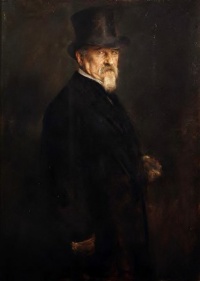Portrait of Giovanni Morelli by Franz von Lenbach in the Accademia Carrara
I’ve just canonized Giovanni Morelli (1816 – 1891) and Carlo Ginzburg (born 1939).
Morelli for paying attention to the details, Ginzburg for painting the big picture.
Morelli on the details:
- “Except the face, probably no part of the human body is more characteristic, individual, significant, and expressive than the hand; to represent it satisfactorily has ever been one of the chief difficulties which artists have had to contend with, and one which only the greatest have been completely successful in overcoming. Of this, both painting and sculpture afford us ample proof. I have given a few examples of characteristic hands.” —Italian Painters[2]
Ginzburg on the big picture:
- “… kinds of knowledge which tend to be unspoken, whose rules […] do not easily lend themselves to being formally articulated or even spoken aloud. Nobody learns how to be a connoisseur or a diagnostician simply by applying the rules. With this kind of knowledge there are factors in play which cannot be measured-a whiff, a glance, an intuition.” –“Morelli, Freud, and Sherlock Holmes“
Whiffs, glances and intuitions are all examples of infrathin, that fine and fuzzy concept of Marcel Duchamp.


